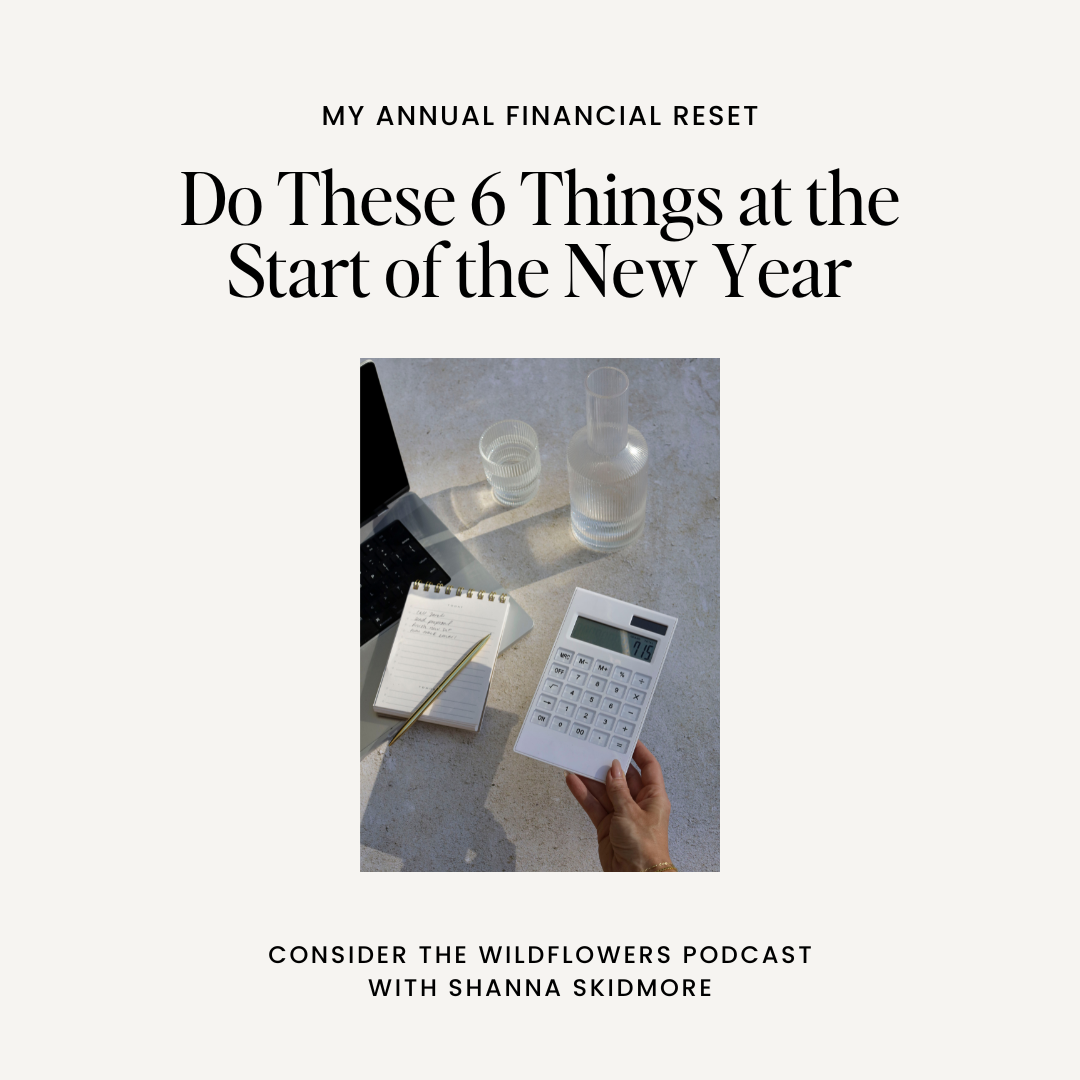Keep Reading
Do These 6 Things at the Start of the New Year: My Annual Financial Reset
APPLE PODCASTS | SPOTIFY Are your small business finances in need of a fresh start?! Whether you’re tuning in right after ringing in the new year or catching this on a random Thursday in May, side-eyeing your bank account and wondering, “Where did it all go?”—this episode is for YOU. Today, I’m pulling back the […]

Paragraph
APPLE PODCASTS | SPOTIFY
Are your small business finances in need of a fresh start?! Whether you’re tuning in right after ringing in the new year or catching this on a random Thursday in May, side-eyeing your bank account and wondering, “Where did it all go?”—this episode is for YOU. Today, I’m pulling back the curtain on my own financial reset for small business owners and sharing the 6 steps I take at the beginning of each year to reset my own personal and business finances for the year ahead.
No fluff, no judgment—just real talk and simple, actionable steps to get you feeling in control of your money. So grab a cup of coffee, a notebook, or maybe just your notes app, and let’s dive in.
Press play for the full interview or keep reading below!

My Annual Financial Reset for Small Business Owners
January is like the first page of a brand-new notebook—full of promise, unblemished by scribbles, and brimming with the hope that this will be the year you finally keep everything neat and organized (even if by February, there’s coffee stains and doodles in the margins). It’s that fresh-start feeling, where anything feels possible, and the plan is to actually stick to the plan this time.
The year is perfect.. If only for a moment.
Now, if you know my backstory—former Fortune 100 financial advisor, self-proclaimed numbers nerd (though, let’s be clear, never a mathlete), and someone who’s been staring at spreadsheets for nearly two decades—you might think, Oh, of course, money stuff comes naturally to her. But let me stop you right there.
Sure, my brain can crunch numbers and spot strategic opportunities faster than most people can find an edge piece in a puzzle. (And yes, if you don’t start with the edge pieces, we need to talk.) But here’s the kicker: nobody ever taught me how to actually manage money.
Yep, you heard that right. Financial planning, budgeting, cash flow management—it wasn’t part of my college accounting curriculum or my corporate training. Shocking, right? Kind of like how doctors don’t get much nutrition training. (Which, honestly, explains a lot when you think about it.)
So, how did I learn all this? Well, trial and error, my friends. And a lot of error.
Whether you’re catching this episode right after ringing in a new year or listening on a random Thursday in May while side-eyeing your bank account and wondering, where did it all go?
Today I’m sharing -copy my homework style- the 6 Financial things I do as a small business owner at the start of every new year to set my year up for financial success.
1. Update (or create) a net worth statement
For your personal finances, this is the ultimate scorecard for your wealth. I believe a net worth statement is the best and most accurate picture of personal wealth.
If you’ve heard of a net worth statement, you either already have one (go you btw) or you’re wondering what it is and if you need one?
Let’s be real, less than half of US households maintain a budget (thanks for the stat, CNN), so I’m guessing fewer have a net worth statement. But I’m telling you, this is the metric. It’s basically the difference between what you own (your assets) and what you owe (your liabilities).
Think of it like a Twitter viral ‘How it started. vs. How it’s going.’ meme—except this time, it’s your wallet, not your latest home project.”
I track our net worth around the same time each year (usually the beginning of January) with the goal of making our net worth number “more positive” each year. Less debt, more assets, simple math.
If this is your first time doing a net worth statement, don’t be surprised (or panic) if your net worth is negative. Knowing your starting point is the first step to getting where you want to go. And a crucial first step in a financial reset for small business owners.
I use a simple google docs spreadsheet to track our net worth. There are a lot of free options online but if you want my exact spreadsheet you can find it in my spreadsheet shop.
Shop My Net Worth Tracker Spreadsheet Template Here
2. Write out (yes, on paper!) a personal budget for the year
Budgeting: the word everyone loves to hate, right? For years, I wandered through life without a written budget. Sure, I could rattle off the basics: rent, car payments, you get the idea. But if you asked me where all my money was actually going—and whether I was spending it in a way that lined up with the future I wanted—I was totally in the dark.
It wasn’t until Kyle and I quit our jobs, moved states, and found ourselves really broke (think sold our cars and biked everywhere) that we finally sat down and figured out how much it actually cost to live our lives each month. And yes, I worked in finance this whole time—still no budget.
Through this journey, here’s what I learned: Budgeting doesn’t have to be this snooze-fest, “no fun allowed” activity. When budgeting shifts from a “no, you can’t” mindset to a plan for your spending, it’s actually pretty freeing (and dare I say fun!).
As Davey Ramsey puts it, “tell your money where to go instead of wondering where it went.”
In day to day life, budget looks like grabbing that viral Studio McGee seasonal decor pillow from Target guilt-free—because I know I’m spending money in a way that aligns with our values and long-term goals.
When I finally switched my mindset from restrictive budget to a freeing “spending plan”—everything clicked. Suddenly, things like travel, hiring a house cleaner, or even taking Fridays off weren’t just “someday” dreams—I could see how they could be reality with a little intentionality (and maybe one less coffee run a week!).
How to start?
A simple exercise: print off your bank statements from last month and see exactly where your money went—bills, random spending, those “extras” that sneak up. And if you’re ready to deep dive and get your budget in place for this year, check out my personal budgeting course, Blueprint at Home. Check it out if you’re ready to get your spending plan (not budget!) on track. I’ll leave a link in the show notes.
3. Set your salary for the year – how much do you need to pay yourself?
This is the fun part—deciding how much money you’re going to actually pay yourself. I mean, it’s your business, right?
Kyle and I both own our own businesses, so we don’t have anyone but us sending over a W2 each month. My secret sauce to personal budgeting is to pay yourself only what you need to cover your bills and maintain the lifestyle you are comfortable with.
Anything above that minimum lifestyle need comes in as a bonus and goes to a completely separate bank account. I’m getting ahead of myself here. Again, if you want to learn more about how we manage our personal budget, check out my personal budgeting course for small business owners called Blueprint at Home.
Before jumping into a new year, I want to make sure I’m crystal clear on how much we need to pay ourselves each month from the business. The reason is this: knowing how much you need personally is the jumping off point for setting your business financial goals.
4. Create a One Year Budget for your business – aka a “money plan”
It won’t come as a surprise but your girl loves a good budget. I mean, I genuinely get excited about this stuff. Seriously. And when it comes to my business, there’s nothing more comforting than having a solid “money plan” for the year. That means knowing, down to the penny, how much it costs to keep the lights on so to speak—staff, software, professional development, and the occasional celebratory dinner for making it through a crazy month.
Budgeting for your business looks similar to making a home budget. Pull out your bank statements and see where all your money is going. How much does it keep the train on the tracks, the payroll paid, and the office cat fed each month? Knowing this number will give you a target for sales.
Related: How to Manage Small Business Finances | My Monthly Money Workflow
5. Set a sales goal – your “enough” number.
Alright, let’s talk about setting your sales goal. This is where the magic happens. Once you know how much it costs to run your business—from your paperclips to your Pinterest-worthy office décor—it’s time to set a sales goal for the year. This is the total amount of revenue the business needs to bring in a year to cover all the bills.
I call this your “enough” number — your peace of mind number!
Knowing exactly how much you need to sell is pure gold. No second guessing if you need to sell more or if you’ll be able to cover all of the expenses. At any point in the year, you’ll be able to glance at a few numbers and know where you stand, and nothing feels more empowering than that.
But I’ll be honest—at first glance, seeing that big scary number can feel like trying to climb Mount Everest in flip-flops. So once I know my “enough” number, that one year sales goal, I break it down!!! In finance lingo, this is your revenue plan. Think product launches, client workload, shop sales per month—the roadmap to hit your goal.
I’m convinced that a business budget (or “money plan,” as I like to call it) is the most crucial financial document you’ll ever need. This is the number that tells you what’s really required to keep your business running, pay yourself, and still have room to grow. It’s your baseline—the no-nonsense amount that you have to hit to keep the wheels turning.
So, how do you calculate your “enough” number? It’s easier than you think:
- Start with Your Personal Salary Need
- Add Tax Savings (don’t ignore this one!)
- Then Add Business expenses
= reverse engineer your way to your Sales Goal (your “Enough” number)
Want an example?!
Say you need to pay yourself $10,000 per month. Add 30% for taxes on top of that, so another $3,000. It takes $2,000 a month to pay your business bills. Add them together and you know the business needs to generate $15,000 per month to cover your pay and the business expenses.
This may not be your “dream big” number or the “bare minimum” number. This is the number that tells you, “If I make this, I’m covered. I can keep the lights on, pay myself, and breathe easy.” And that, my friend, is peace of mind.
Knowing that I have to sell $15,000 in products or services each month is empowering, and stress relieving! It gives me permission to pivot, slow down, or—gasp—take a break if needed and is that extra push I need to go after that new client or run a flash sale to generate a little more cash.
Talk to any of my students, and they’ll tell you my philosophy of defining “enough” as a game-changer.
It’s not just about hitting the next big milestone; it’s about finding that sweet spot for you. The place where ambition and contentment meet. Permission to jump off the hamster wheel of “never enough”.
6. Set your financial goals for the year
Looking at your net worth statement are there any debts you want to tackle, or to increase your savings goal. Looking at your budget, is there room to increase your personal pay or sales goal in order to take that dream vacation or hire that new team member. What financial goals will move you closer to the life and business of your dreams. I limit financial goals to no more than 3.
Alright, there you have it. The 6 steps I take at the beginning of each year to set my business and personal life up for financial success. This financial reset for small business owners is the perfect way to kickstart a new year or turn a new leaf in your entrepreneurial journey.
Related: Currently planning out for the year ahead? You’ll love my two-part podcast series on reflecting and goal setting. Listen here ➡️ Part One: End of Year Business Review & Part Two: Why Goal Setting is Overrated (+ What To Do Instead)
📌 RESOURCES MENTIONED:
Shanna’s Net Worth Spreadsheet
SHARE THIS:
January 2, 2025
Previous Post:
Next Post:


And if you found this helpful, share with your friends!